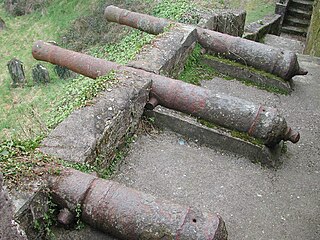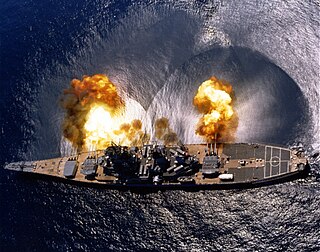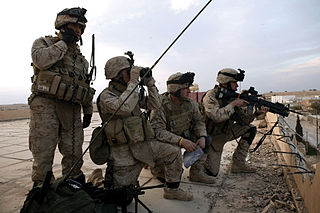
In military organizations, an artillery battery is a unit of artillery, mortars, rocket artillery, multiple rocket launchers, surface to surface missiles, ballistic missiles, cruise missiles, etc., so grouped to facilitate better battlefield communication and command and control, as well as to provide dispersion for its constituent gunnery crews and their systems. The term is also used in a naval context to describe groups of guns on warships.

Naval gunfire support (NGFS) is the use of naval artillery to provide fire support for amphibious assault and other troops operating within their range. NGFS is one of a number of disciplines encompassed by the term naval fires. Modern naval gunfire support is one of the three main components of amphibious warfare assault operations support, along with aircraft and ship-launched land-attack missiles. Shipborne guns have been used against shore defences since medieval naval warfare.

In military science, suppressive fire is "fire that degrades the performance of an enemy force below the level needed to fulfill its mission". Suppression is usually only effective for the duration of the fire. It is one of three types of fire support, which is defined by NATO as "the application of fire, coordinated with the maneuver of forces, to destroy, neutralize or suppress the enemy."

A military artillery observer,spotter or FO is responsible for directing artillery and mortar fire onto a target and may be a Forward Air Controller (FAC) for close air support and spotter for naval gunfire support. Also known as Fire Support Specialist or FISTer, an artillery observer usually accompanies a tank or infantry manoeuvre unit. Spotters ensure that indirect fire hits targets which the troops at the fire support base cannot see.

Field artillery is a category of mobile artillery used to support armies in the field. These weapons are specialized for mobility, tactical proficiency, short range, long range, and extremely long range target engagement.

The Tactical Air Control Party, commonly abbreviated TACP, is a small team of air force or marine personnel who provide airspace deconfliction, command and control communications, and terminal control of close air support at battlegroup level or below.
Infantry tactics are the combination of military concepts and methods used by infantry to achieve tactical objectives during combat. The role of the infantry on the battlefield is, typically, to close with and engage the enemy, and hold territorial objectives; infantry tactics are the means by which this is achieved. Traditionally infantry have made up the largest proportion of an army's fighting strength, and consequently often suffer the heaviest casualties. Throughout history, infantrymen have sought to minimise their losses in both attack and defence through effective tactics.

Air Naval Gunfire Liaison Company (ANGLICO) is an airborne fire support and liaison unit of the United States Marine Corps. The mission of ANGLICO is "To provide Marine Air-Ground Task Force (MAGTF) Commanders a liaison capability to plan, coordinate, and conduct terminal control of fires in support of joint, allied, and coalition forces." Per this mission statement, ANGLICOs are not designed to support U.S. Marine Corps maneuver elements. Instead, the doctrinal purpose of ANGLICO is to provide fire support and coordination in support of units adjacent to the MAGTF.

The Battle of Coral–Balmoral was a series of actions fought during the Vietnam War between the 1st Australian Task Force and the North Vietnamese 7th Division and Viet Cong Main Force units, 40 kilometres (25 mi) north-east of Saigon. Following the defeat of the communist Tet offensive in January and February, in late April two Australian infantry battalions—the 1st and 3rd Battalions of the Royal Australian Regiment (RAR)—with supporting arms, were again deployed from their base at Nui Dat in Phước Tuy Province to positions astride infiltration routes leading to Saigon to interdict renewed movement against the capital. Part of the wider allied Operation Toan Thang I, it was launched in response to intelligence reports of another impending communist offensive, yet the Australians experienced little fighting during this period. Meanwhile, the Viet Cong successfully penetrated the capital on 5 May, plunging Saigon into chaos during the May Offensive in an attempt to influence the upcoming Paris peace talks scheduled to begin on the 13th. During three days of intense fighting the attacks were repelled by US and South Vietnamese forces, and although another attack was launched by the Viet Cong several days later, the offensive was again defeated with significant losses on both sides, causing extensive damage to Saigon and many civilian casualties. By 12 May the fighting was over, and the North Vietnamese and Viet Cong were forced to withdraw having suffered heavy casualties. US casualties were also heavy and it proved to be their most costly week of the war.
148 (Meiktila) Commando Forward Observation Battery is a specialist Naval Gunfire Support Forward Observation (NGSFO) unit within 29 Commando Regiment Royal Artillery of 3 Commando Brigade Royal Marines.
29 Commando Regiment is the Commando-trained unit of the British Army's Royal Artillery, based in Plymouth. The regiment is under the operational control of 3 Commando Brigade, to which it provides artillery support and gunnery observation.

In the land-based field artillery, the field artillery team is organized to direct and control indirect artillery fire on the battlefield. Since World War I, to conduct indirect artillery fire, three distinct components have evolved in this organization: the forward observer, the fire direction center (FDC) and what is called the gun line. On the battlefield, the field artillery team consists of some combinations of all of these elements. In other words, there may be multiple FOs calling in fire on multiple targets to multiple FDCs and any component may be in communication with some of the other elements depending on the situational requirements.
Aerial rocket artillery is a type of armed helicopter unit that was part of the artillery component of the United States Army's two airmobile divisions during the Vietnam War. Controlled by division artillery and not the aviation group, the 2nd Battalion, 20th Artillery, 1st Cavalry Division and the 4th Battalion, 77th Artillery, 101st Airborne Division, along with Battery F, 79th Artillery, 1st Cavalry Division, were the only ARA units fielded during that conflict. The ARA concept disappeared from Army aviation by the mid-1970s, replaced by more generic attack aviation units.

40th Regiment Royal Artillery – The Lowland Gunners – was a regiment of the Royal Artillery in the British Army. It supported 19 Light Brigade in the field artillery role. It was structured into Fire Support Teams equipped with MSTAR, and the regiment's three gun batteries, equipped with eighteen L118 Light Guns. The Clan Home tartan was worn by the regiment.

Special reconnaissance (SR) is conducted by small units of highly trained military personnel, usually from special forces units or military intelligence organizations, who operate behind enemy lines, avoiding direct combat and detection by the enemy. As a role, SR is distinct from commando operations, but both are often carried out by the same units. The SR role frequently includes covert direction of air and missile attacks, in areas deep behind enemy lines, placement of remotely monitored sensors and preparations for other special forces. Like other special forces, SR units may also carry out direct action (DA) and unconventional warfare (UW), including guerrilla operations.
The Battle of Prek Klok II occurred on March 10, 1967, during Operation Junction City when American military forces were conducting a search and destroy operation against the Viet Cong (VC) forces in Tay Ninh Province west of the capital of South Vietnam, Saigon. During the course of the operation they had already had a significant engagement in the Battle of Prek Klok I. During the night, Artillery Fire Support Patrol Base II at Prek Klok was attacked by two communist battalions, resulting in a short battle. This was the second major battle of Operation Junction City. The VC started by mortaring the base and launching anti-tank fire at the M113 armored personnel carriers (APCs) surrounding the base. Attacks came from the north and east, followed by an infantry charge out of wooded areas from the southwest. With the help of air strikes from nearby planes, as well as artillery and ample supplies flown in by helicopter, the Americans easily repelled the communist attack. The Americans killed 197 VC but lost only three of their men.
The Battle of Ap Gu occurred during 31 March and 1 April 1967 during Operation Junction City, a search and destroy mission by American military forces in Tay Ninh Province of South Vietnam, to the west of the capital Saigon. The battle near the border with Cambodia left 609 Viet Cong (VC) killed according to US sources, with 5 captured, and over 50 weapons of all types recovered, while the Americans lost 17 killed and 102 wounded.
The Battle of Suoi Tre occurred during the early morning of 21 March 1967 during Operation Junction City, a search and destroy mission by American military forces in Tay Ninh Province of South Vietnam, to the west of the capital Saigon. After being challenged heavily to begin with, the Americans gained the upper hand and completed a convincing victory over the Viet Cong (VC). They claimed to have found 647 bodies and captured seven prisoners, while recovering 65 crew-served and 94 individual weapons. The Americans losses were 36 dead and 190 wounded, a fatality ratio of more than twenty to one in their favour.
Forward observers in the U.S. military are artillery observers who carry the Military Occupational Specialty designator of 13F in the United States Army and 0861 in the United States Marine Corps. They are officially called Joint Fire Support Specialists in the U.S. Army and Fire Support Men in the U.S. Marine Corps. They are colloquially known as FiSTers, regardless of whether they are members of a FiST. The Battalion Fire Support Officer (FSO) is the Officer in Charge of a Battalion Fire Support Element.













